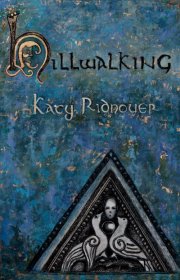
The two women who answer Heather’s ad are also Americans. Jamie, married with two children, is from Texas and Christy, married with no children yet, is from Virginia. Gradually the three women learn to trust and care for one another, trading challenging insights and building a strong sense of community. Hillwalking alternates its chapters between these three women individually and collectively.
As they explore the paths of Glendalough, an ancient city of monks, Heather is taken in by the architecture and designs to be found among the ruins. She once practiced the art of tinsmithing and sketches some of the designs, trusting her curiosity to lead her somewhere. In her workshop at home, she begins to apply her design sketches to ceiling tiles, becoming more emotionally immersed in her art than her strict husband, a minister, would like to see happen. Nonetheless, Heather continues her hammering but it’s not enough. Again trusting her curiosity, she randomly happens upon a book about St. Kevin while browsing in her husband’s private library.
She seeks permission from her skeptical husband to teach a Sunday school class in his church: “I want them to know about St. Kevin. He was just like them, trying to figure out how to get along with people and still do God’s work.” It is here that Ridnouer’s background as a teacher comes into play. I was absolutely delighted with the images of a Sunday school class holding a Socratic discussion: They were rabbits, holding themselves still, hoping they’ll go unnoticed. Heather continued, “I’m going to read you a story, and then how about we have a chat after?” Our narrator presents the scenes in the class respectfully and lovingly.
In addition to the history of St. Kevin and the geography around Glendalough we learn of the spiritual application of labyrinths, but this religious backdrop is not by way of a preachy narrative voice. Rather, the characters’ interest in and passion for what they are learning (both personally and historically) rings true. The author’s stylistic weaving of her personal and professional experience into a novel reminds me a bit of Barbara Kingsolver’s fiction.
I felt drawn into the journeys of these three women without feeling expected to attend church myself. (Indeed, as Jamie declares: “Oh, but I do attend church! I attend the House of the Holy Comforter. My lavender comforter is my favorite.”) There is a wonderful blend of the mundane with the spiritual in this story that I found relatable while watching each woman find her own way. Jamie is a sort of Warrior Woman and Heather is a Peace Woman, with Christy being a combination.
The adult male characters in this novel are not developed, with the exception of St. Kevin, whom we get to know when Heather reads his writings to her class. This is not a criticism, just a mention. Taking us into the world of three women from their points of view only is perhaps essential for purposes of trailing along as they each find a true path with heart. Hillwalking is well written, emotionally involving, gently educational, spiritually accurate, and please excuse me but I feel like going for a walk now. Five stars.
Links
Get an Editorial Review | Get Amazon Sales & Reviews | Get Edited | Get Beta Readers | Enter the SPR Book Awards | Other Marketing Services






















Leave A Comment